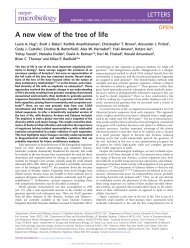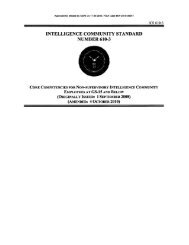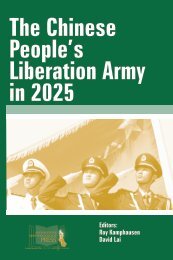The Joint Force in a Contested and Disordered World
JCS-JOE-2035
JCS-JOE-2035
Create successful ePaper yourself
Turn your PDF publications into a flip-book with our unique Google optimized e-Paper software.
Human Geography <strong>and</strong> the Future <strong>Jo<strong>in</strong>t</strong> <strong>Force</strong><br />
“Time <strong>and</strong> aga<strong>in</strong> it has been <strong>in</strong> the wake of the decl<strong>in</strong>e of empires, <strong>in</strong> contested borderl<strong>and</strong>s,<br />
or <strong>in</strong> power vacuums, that the opportunities have arisen for genocidal regimes <strong>and</strong> policies.<br />
Ethnic confluence, economic volatility, <strong>and</strong> empires on the wane; such was <strong>and</strong> rema<strong>in</strong>s<br />
the fatal formula.” 7<br />
<strong>The</strong> <strong>Jo<strong>in</strong>t</strong> <strong>Force</strong> will face a future socio-cultural world largely<br />
def<strong>in</strong>ed by the conditions depicted <strong>in</strong> Figure 3. <strong>The</strong> future security<br />
environment will feature large areas of the globe where states<br />
struggle to ma<strong>in</strong>ta<strong>in</strong> a monopoly on violence <strong>and</strong> <strong>in</strong>dividual<br />
identities are no longer based exclusively on a sense of physical<br />
location. Individuals <strong>and</strong> groups will connect <strong>and</strong> socialize globally.<br />
Widespread economic growth will raise millions out of poverty <strong>in</strong>to<br />
longer <strong>and</strong> more comfortable lives. However, a richer human world<br />
lack<strong>in</strong>g legally constituted <strong>and</strong> legitimate governance may lead to<br />
dissatisfaction, violence, <strong>and</strong> even the emergence of violent<br />
transnational ideologies that disrupt local, state, or regional<br />
governments. Grow<strong>in</strong>g wealth can also stress food, water, energy,<br />
<strong>and</strong> other resources, caus<strong>in</strong>g higher prices <strong>and</strong> shortages which may<br />
translate <strong>in</strong>to <strong>in</strong>stability, civil conflict, <strong>and</strong> the failure of<br />
governments. Fractured <strong>and</strong> failed governments may transmit<br />
disorder more broadly or become geopolitical opportunities for<br />
more well-ordered <strong>and</strong> aggressive states.<br />
Figure 3. Conditions <strong>in</strong><br />
Human Geography<br />
Intensify<strong>in</strong>g Consequences of Population Growth <strong>and</strong> Migration<br />
By 2035, the global population is expected to <strong>in</strong>crease by another 1.8 billion people to a total of<br />
nearly 9 billion people, with almost all of this growth occurr<strong>in</strong>g <strong>in</strong> the develop<strong>in</strong>g world <strong>and</strong> largely<br />
centered <strong>in</strong> urban areas. When properly harnessed, population <strong>in</strong>creases <strong>and</strong> urbanization can<br />
translate <strong>in</strong>to stronger economic development <strong>and</strong> expansion. However, massive population<br />
growth <strong>and</strong> migration might stress governments to the break<strong>in</strong>g po<strong>in</strong>t where they are unable to<br />
effectively manage resources <strong>and</strong> meet their citizens’ basic needs. Unequal rates of economic<br />
growth <strong>and</strong> the lack of opportunity are already <strong>in</strong>duc<strong>in</strong>g unexpected migrant flows, stress<strong>in</strong>g<br />
recipient states <strong>and</strong> limit<strong>in</strong>g the prospects for growth <strong>and</strong> development <strong>in</strong> places they leave beh<strong>in</strong>d.<br />
<strong>The</strong> <strong>in</strong>tensify<strong>in</strong>g consequences of population growth <strong>and</strong> migration are likely to result from several<br />
important trends:<br />
Asymmetric population growth patterns. <strong>The</strong> center of gravity for the world’s population<br />
cont<strong>in</strong>ues to shift from the developed world to the develop<strong>in</strong>g world. <strong>The</strong> highest growth <strong>in</strong><br />
population is likely to occur <strong>in</strong> Africa, while the populations of most countries <strong>in</strong> South Asia<br />
<strong>and</strong> the Middle East are expected to cont<strong>in</strong>ue ris<strong>in</strong>g, with India surpass<strong>in</strong>g Ch<strong>in</strong>a as early as<br />
2022 as the most populous nation on Earth.<br />
Mass migration <strong>and</strong> irreconcilable immigrants. <strong>The</strong> mix<strong>in</strong>g of new people, ideas, culture,<br />
<strong>and</strong> ideologies can result <strong>in</strong> unrest <strong>and</strong> conflict between those mov<strong>in</strong>g <strong>in</strong> <strong>and</strong> native citizens.<br />
7<br />
Niall Ferguson, <strong>The</strong> War of <strong>The</strong> <strong>World</strong>, (2006), p. 646<br />
10











